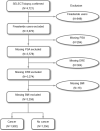Is there a role for body mass index in the assessment of prostate cancer risk on biopsy?
- PMID: 24747090
- PMCID: PMC4194238
- DOI: 10.1016/j.juro.2014.04.015
Is there a role for body mass index in the assessment of prostate cancer risk on biopsy?
Abstract
Purpose: We examine the role of body mass index in the assessment of prostate cancer risk.
Materials and methods: A total of 3,258 participants who underwent biopsy (including 1,902 men with a diagnosis of prostate cancer) were identified from the Selenium and Vitamin E Cancer Prevention Trial. The associations of body mass index with prostate cancer and high grade prostate cancer were examined using logistic regression, adjusting for age, race, body mass index adjusted prostate specific antigen, digital rectal examination, family history of prostate cancer, biopsy history, prostate specific antigen velocity, and time between study entry and the last biopsy. The prediction models were compared with our previously developed body mass index adjusted Prostate Cancer Prevention Trial prostate cancer risk calculator.
Results: Of the study subjects 49.1% were overweight and 29.3% were obese. After adjustment, among men without a known family history of prostate cancer, increased body mass index was not associated with a higher risk of prostate cancer (per one-unit increase in logBMI OR 0.83, p=0.54) but was significantly associated with a higher risk of high grade prostate cancer (ie Gleason score 7 or greater prostate cancer) (OR 2.31, p=0.03). For men with a known family history of prostate cancer the risks of prostate cancer and high grade prostate cancer increased rapidly as body mass index increased (prostate cancer OR 3.73, p=0.02; high grade prostate cancer OR 7.95, p=0.002). The previously developed risk calculator generally underestimated the risks of prostate cancer and high grade prostate cancer.
Conclusions: Body mass index provided independently predictive information regarding the risks of prostate cancer and high grade prostate cancer after adjusting for other risk factors. Body mass index, especially in men with a known family history of prostate cancer, should be considered for inclusion in any clinical assessment of prostate cancer risk and recommendations regarding prostate biopsy.
Keywords: body mass index; neoplasm grading; prostate-specific antigen; prostatic neoplasms; risk factors.
Copyright © 2014 American Urological Association Education and Research, Inc. Published by Elsevier Inc. All rights reserved.
Figures
References
-
- Renehan AG, Tyson M, Egger M, Heller RF, Zwahlen M. Body-mass index and incidence of cancer: a systematic review and meta-analysis of prospective observational studies. Lancet. 2008;371:569–78. - PubMed
-
- Calle EE, Rodriguez C, Walker-Thurmond K, Thun MJ. Overweight, Obesity, and Mortality from Cancer in a Prospectively Studied Cohort of U.S. Adults. New England Journal of Medicine. 2003;348:1625–38. - PubMed
-
- Wright ME, Chang SC, Schatzkin A, et al. Prospective study of adiposity and weight change in relation to prostate cancer incidence and mortality. Cancer. 2007;109:675–84. - PubMed
Publication types
MeSH terms
Substances
Grants and funding
LinkOut - more resources
Full Text Sources
Other Literature Sources
Medical



